

Mba.tuck.dartmouth.edu/pages/faculty/andrew.bernard/oscars.pdf. Rucking Good Stats. Welcome to ruckingoodstats.com Rather than trawl through our site to find recent stats of the games here they are below.
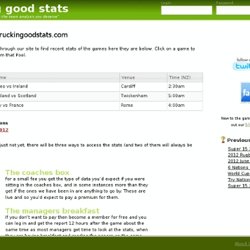
Click on a game to see the games from that Pool. Upcoming Games Current Competitions European Tour 2012. Portal:Baseball. Baseball Statistics and Analysis. Sandy Alderson. Life and career[edit] The son of an Air Force pilot, John Lester Alderson, who flew missions during World War II, Korea and Vietnam,[2] Alderson attended Dartmouth College on a NROTC scholarship and graduated in 1969.[3] He was born to mother Gwenny Parry Alderson.
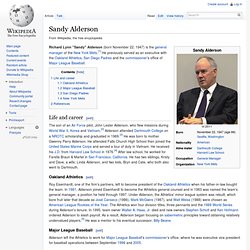
He attended Falls Church High School then joined the United States Marine Corps and served a tour of duty in Vietnam. He received his J.D. from Harvard Law School in 1976.[4] After law school, he worked for Farella Braun & Martel in San Francisco, California. He has two siblings, Kristy and Dave, a wife, Linda Alderson, and two kids, Bryn and Cate, who both also went to Dartmouth. Oakland Athletics[edit] Baseball Prospectus. Baseball Prospectus (BP) is an organization that publishes a website, BaseballProspectus.com, devoted to the sabermetric analysis of baseball.

BP has a staff of regular columnists and provides advanced statistics as well as player and team performance projections on the site. Since 1996 the BP staff has also published a Baseball Prospectus annual as well as several other books devoted to baseball analysis and history. Baseball Prospectus has fathered several popular new statistical tools that have become hallmarks of baseball analysis. Bill James. Podcast: Bill James, Legendary Baseball Writer and Analyst. Works of Bill James. Bill James is probably the most widely known purveyor of what is known as "Sabermetrics". He is also often cited by researchers in discussions, but often without them knowing the exact citation. He would often publish studies, especially in the Abstracts, which would not be easily located. This is the beginning of an attempt to gather that information (the location of the various studies) and put it in one place.
Doing a complete indexing of the Abstracts and other books by Bill James is a lengthy and tedious project which is just getting under way. So I have started with overviews of the books that I have, which are essentially the Table of Contents, sometimes with a little extra information. I have also listed the articles that he wrote in the Baseball Analyst Newsletter, which he published, and those that I know about in other books, newspapaers and magazines.
Stephen Roney President, Allan Roth Chapter, SABR sroneysabr@cox.net Annuals Books "Bill James Presents" Newletters Newsletters. Bill James Online. Sabermetrics. Introduction to sabemetrics. By Jim Albert.
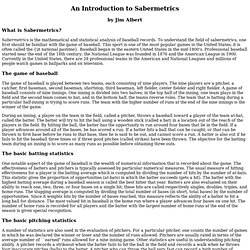
How Sabermetrics Works" Was Mark Twain right when he said, "There are three kinds of lies: lies, damned lies and statistics"?
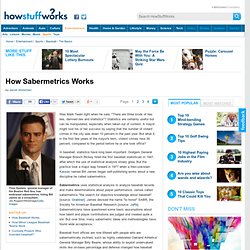
Statistics are certainly useful but can be manipulated, especially when taken out of context. A mayor might tout his or her success by saying that the number of violent crimes in the city was down 10 percent in the past year. Defensive spectrum. In sabermetrics, the defensive spectrum is the graphical representation of the positions on a baseball field, arranged from left (the easiest defensive positions) to right (the hardest).
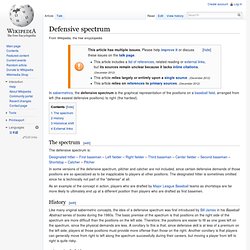
The spectrum[edit] The defensive spectrum is: Designated hitter – First baseman – Left fielder – Right fielder – Third baseman – Center fielder – Second baseman – Shortstop – Catcher – Pitcher. Similarity score. In Sabermetrics and APBRmetrics, similarity scores are a method of comparing baseball and basketball players (usually in MLB or the NBA) to other players, with the intent of discovering who the most similar historical players are to a certain player.
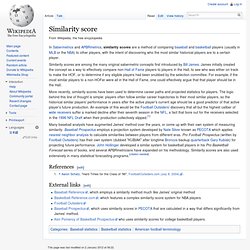
Similarity scores are among the many original sabermetric concepts first introduced by Bill James. James initially created the concept as a way to effectively compare non-Hall of Fame players to players in the Hall, to see who was either on track to make the HOF, or to determine if any eligible players had been snubbed by the selection committee. Win shares. Win Shares is a book (ISBN 1-931584-03-6) about baseball written by Bill James and Jim Henzler, published by STATS, Inc. in 2002.
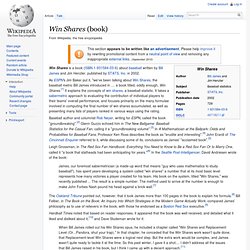
As ESPN's Jim Baker put it, "we've been talking about Win Shares, the baseball metric Bill James introduced in .... a book titled, oddly enough, Win Shares.[1] It explains the concepts of win shares, a baseball statistic. It takes a sabermetric approach to evaluating the contribution of individual players to their teams' overall performance, and focuses primarily on the many formulae involved in computing the final number of win shares accumulated, as well as presenting many lists of players ranked in various ways using the rating. Leigh Grossman, in The Red Sox Fan Handbook: Everything You Need to Know to Be a Red Sox Fan Or to Marry One, called it "a book that statheads had been anticipating for years. Keltner list. The Keltner list is a systematic but non-numerical method for considering whether a baseball player is deserving of election to the National Baseball Hall of Fame in Cooperstown, New York.[1] It makes use of an inventory of questions (mostly yes-or-no format) regarding the merit of players relative to their peers.

Enshrinement in the Hall of Fame is the highest honor in baseball, with only 236 players having been inducted as of 2012. Election to the Hall is also permanent. However, selection for the Hall is by election; no "cut-offs" or objective criteria exist (other than rules about how players become eligible for election).[2] It can therefore be difficult for voters and fans alike to determine which former players are deserving of the honor. The Keltner list comprises 15 questions designed to aid in the thought process. Each question is designed to be relatively easy to answer. History[edit] Rain Delay (essay)